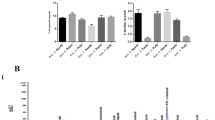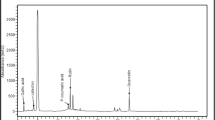Abstract
The aim of this investigation was to evaluate the biological, alcohol dehydrogenase (ADH) and antiproliferative activities of different extracts of mungbean seeds and sprouts. All extracts from the sprouts showed higher contents of total phenolics (TP), total flavonoids (TF), and 1,1-diphenyl-2-picrylhydrazyl (DPPH) radical scavenging activity than from seeds. The highest DPPH and tyrosinase inhibition activities were registered in ethyl acetate (EtOAc) extract. ADH activity of methanol (MeOH), n-hexane (n-hexane) and n-butanol (n-BuOH) extracts from sprouts was significantly higher (P < 0.05) than from seeds. However, the highest ADH activity was found in water extract of seeds. According to 3-(4, 5-dimethylthiazol -2-yl)-2, 5-diphenyltetrazolium bromide) (MTT) assay, extracts from sprouts were more effective against Calu-6 (human pulmonary carcinoma) and SNU-601 (human gastric carcinoma) cells than from seeds. EtOAc extract showed the highest antiproliferative activity in both sprouts and seeds, followed by n-hexane extraction. During sprouting of mungbean, all the studied components significantly increased. In conclusion, the extracts of sprouts are more effective than from seeds and could be a potential source of antioxidants linked with health benefits.

Similar content being viewed by others
Abbreviations
- ADH:
-
Alcohol dehydrogenase
- Calu-6:
-
Human pulmonary carcinoma cell line
- DPPH:
-
1, 1-diphenyl-2-picrylhydrazyl radical
- MTT:
-
3-(4, 5-dimethylthiazol -2-yl)-2, 5-diphenyltetrazolium bromide
- SNU-601:
-
Human gastric carcinoma cell line
References
Thomas RMJ, Fukaic S, Peoples MB (2004) The effect of timing and severity of water deficit on growth, development, yield accumulation and nitrogen fixation of mungbean. Field Crop Res 86:67–80
Choi Y, Jeong H-S, Lee J (2007) Antioxidant activity of methanolic extracts from some grains consumed in Korea. Food Chem 103:130–138
Samotyja U, Zdzieblowski T, Szlachta M, Malecka M (2007) Antioxidant properties of extracts from plant germs. Zywnosc 14:122–128
Cevallos-Casals BA, Cisneros-Zevallos L (2010) Impact of germination on phenolic content and antioxidant activity of 13 edible seed species. Food Chem 119:1485–1490
Cao D, Li H, Yi J, Zhang J, Che H, Cao J, Yang L, Zhu Ch, Jiang W (2011) Antioxidant properties of the mungbean flavonoids on alleviating heat stress. PLoS One 6:e21070
Anwar F, Latif S, Przybylski R, Sultana B, Ashraf M (2007) Chemical composition and antioxidant activity of seeds of different cultivars of mungbean. J Food Sci 72:S503–S510
Pasko P, Sajewicz M, Gorinstein S, Zachwieja Z (2008) Analysis of the selected phenolic acids and flavonoids in Amaranthus cruentus and Chenopodium quinoa seeds and sprouts by HPLC method. Acta Chromatographica 20:661–672
Liu B, Guo X, Zhu K, Liu Y (2011) Nutritional evaluation and antioxidant activity of sesame sprouts. Food Chem 129:799–803
Heo BGu, Chon SU, Park YJ, Bae JH, Park SM, Park YS, Jang HG, Gorinstein S (2009) Antiproliferative activity of Korean wild vegetables on different human tumor cell lines. Plant Foods Hum Nutr 64:257–263
Chon SU, Heo BG, Park YS, Kim DK, Gorinstein S (2009) Total phenolics level, antioxidant activities and cytotoxicity of young sprouts of some traditional Korean salad plants. Plant Foods Hum Nutr 64:25–31
Russo GL (2007) Ins and outs of dietary phytochemicals in cancer chemoprevention. Biochem Pharm 74:533–544
Estomba D, Ladio A, Lozada M (2006) Medicinal wild plant knowledge and gathering patterns in a Mapuche community from North-western Patagonia. J Ethnopharmacol 103:109–119
Manosroi J, Dhumtanom P, Manosroi A (2006) Anti-proliferative activity of essential oil extracted from Thai medicinal plants on KB and P338 cell lines. Cancer Lett 235:114–120
Wongekalak L, Sakulsom P, Jirasripongpun K, Hongsprabhas P (2011) Potential use of antioxidative mungbean protein hydrolysate as an anticancer asiatic acid carrier. Food Res Int 44:812–817
Singleton VL, Rossi JA (1965) A colorimetry of total phenolics with phosphomolybdic-phosphotungstic acid reagents. Am J Enol Viticult 16:144–158
Bao JS, Cai Y, Sun M, Wang GY, Corke H (2005) Anthocyanins, flavonoids, and free radical scavenging activity of Chinese bayberry (Myrica rubra) extracts and their color properties and stability. J Agric Food Chem 53:2327–2332
Blosi MS (1958) Antioxidant determinations by use of a stable free radical. Nature 26:1199–1200
Chen QX, Kubo I (2002) Kinetics of mushroom tyrosinase inhibition by quercetin. J Agric Food Chem 50:4108–4112
Lebsack ME, Petersen DR, Collins AC (1977) Preferential inhibition of the low Km aldehyde dehydrogenase activity by pargyline. Biochemical Pharmacol 26:1151–1154
SAS (Statistical Analysis Systems) Institute. 2000. SAS/STAT user’s guide. Version 7. Electronic Version. Cary, NC
Jastrzębski Z, Tashma Z, Katrich E, Gorinstein S (2007) Biochemical characteristics of the herb mixture Prolipid as a plant food supplement and medicinal remedy. Plant Foods Hum Nutr 62:145–150
Jung MJ, Heo SI, Wang MH (2008) Free radical scavenging and total phenolic contents from methanolic extracts of Ulmus davidiana. Food Chem 108:482–487
Velioglu YS, Mazza G, Gao L, Oomah BD (1998) Antioxidant activity and total phenolics in selected fruits, vegetables, and grain products. J Agric Food Chem 46:4113–4117
Zhou K, Yu L (2006) Total phenolic contents and antioxidant properties of commonly consumed vegetables grown in Colorado. LWT - Food Sci Technol 39:1155–1162
Vellingiri V, Nandety A, Biesalski HK (2011) Antioxidant potential and health relevant functionality of traditionally processed Cassia hirsuta L. seeds: An Indian underutilized food legume. Plant Foods Hum Nutr 66:245–253
Lee K-G, Shibamoto T (2000) Antioxidant properties of aroma compounds isolated from soybeans and mung Beans. J Agric Food Chem 48:4290–4293
McCue P, Kalidas S (2002) A biochemical analysis of mungbean (Vigna radiata) response to microbial polysaccharides and potential phenolic-enhancing effects for nutraceutical applications. Food Biotechnol 16:57–79
Kittipongpatana OS, Burapadaja S, Kittipongpatana N (2009) Carboxymethyl mungbean starch as a new pharmaceutical gelling agent for topical preparation. Drug Dev Ind Pharm 35:34–42
Acknowledgment
Special thanks to Mrs. Judy Siegel-Itzkovich, The Jerusalem Post’s Health & Science Reporter, for her help in improving the English style of the manuscript.
Author information
Authors and Affiliations
Corresponding author
Rights and permissions
About this article
Cite this article
Kim, DK., Jeong, S.C., Gorinstein, S. et al. Total Polyphenols, Antioxidant and Antiproliferative Activities of Different Extracts in Mungbean Seeds and Sprouts. Plant Foods Hum Nutr 67, 71–75 (2012). https://doi.org/10.1007/s11130-011-0273-x
Published:
Issue Date:
DOI: https://doi.org/10.1007/s11130-011-0273-x




